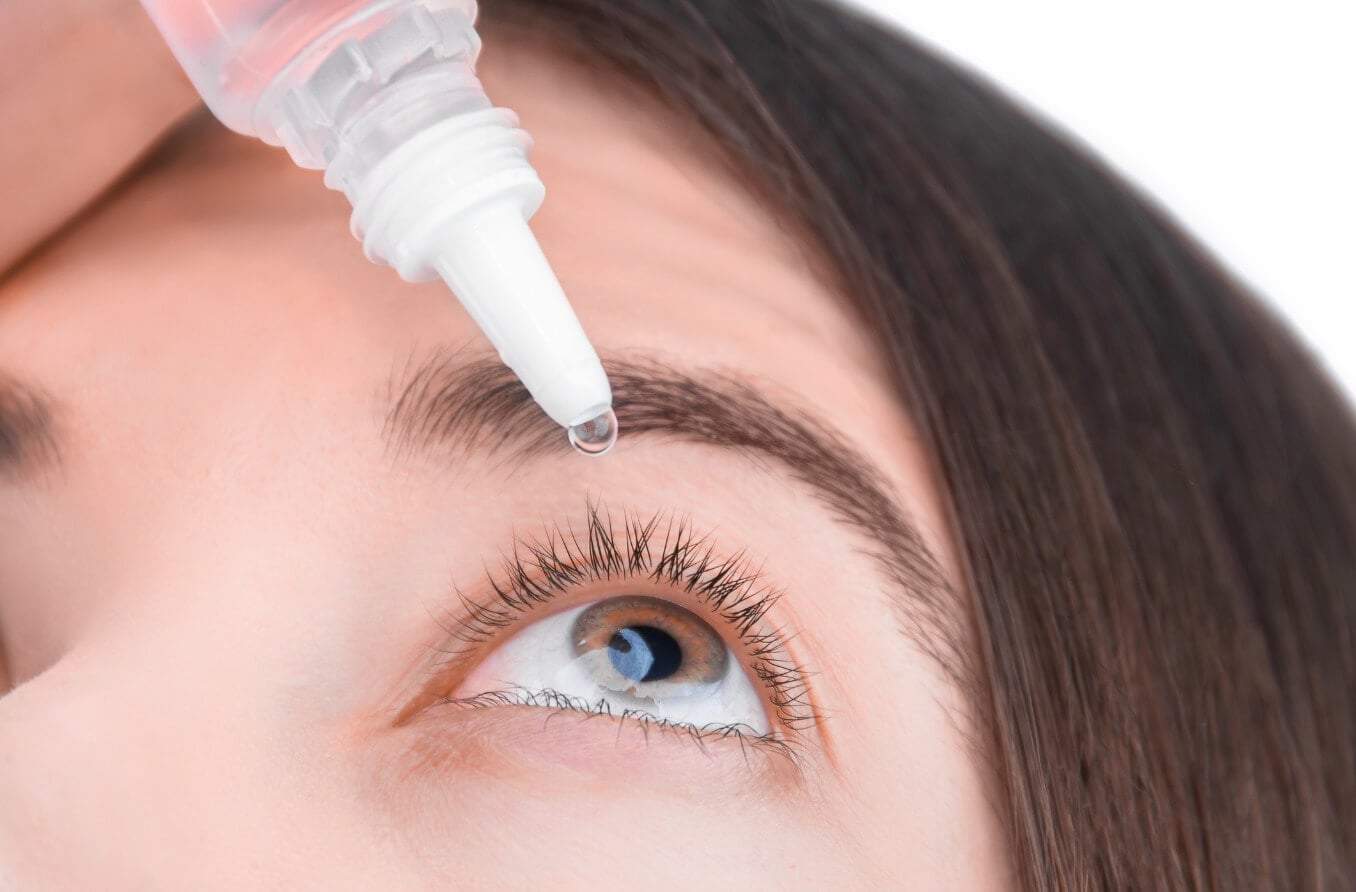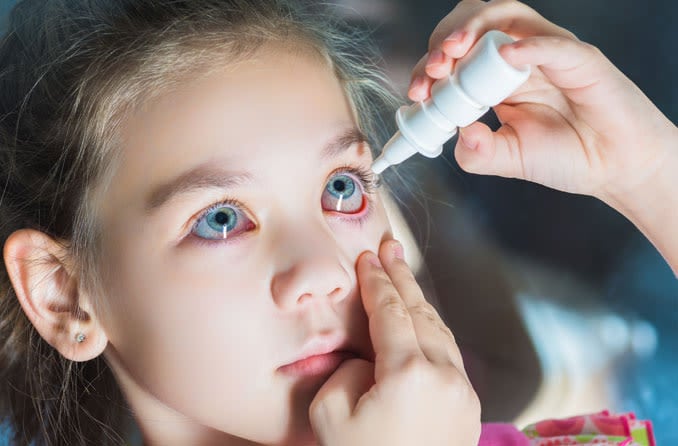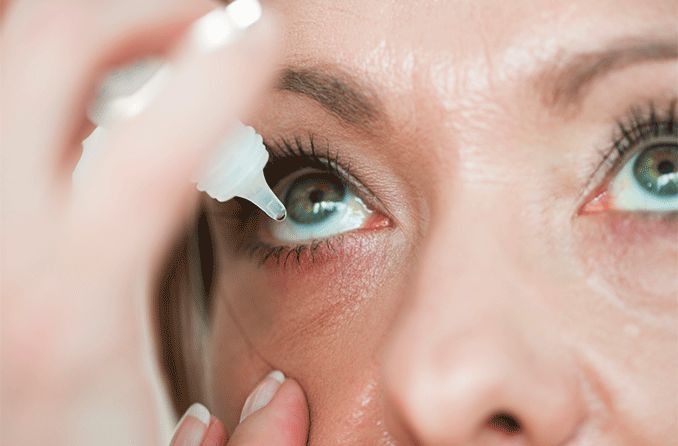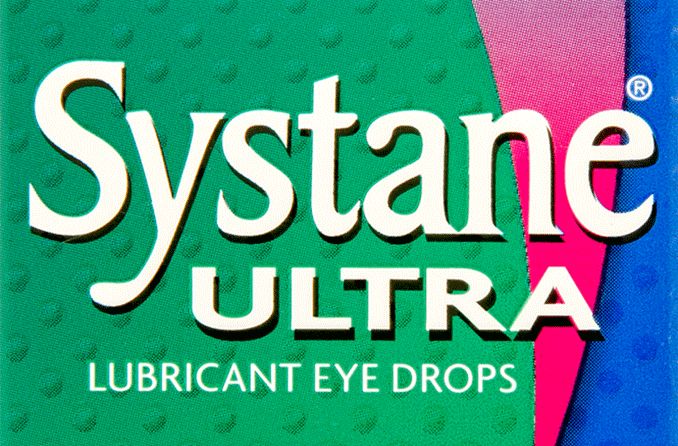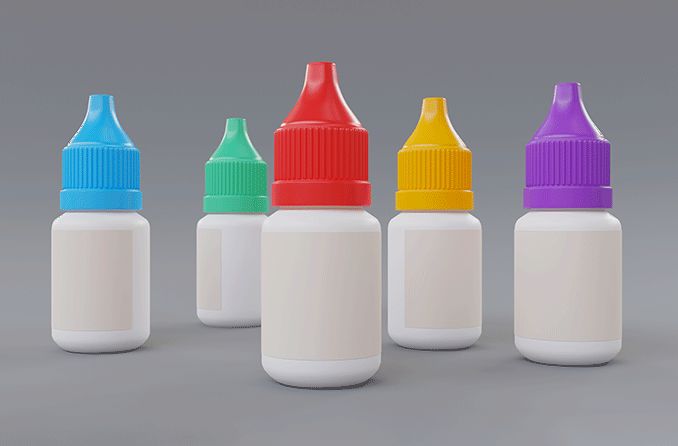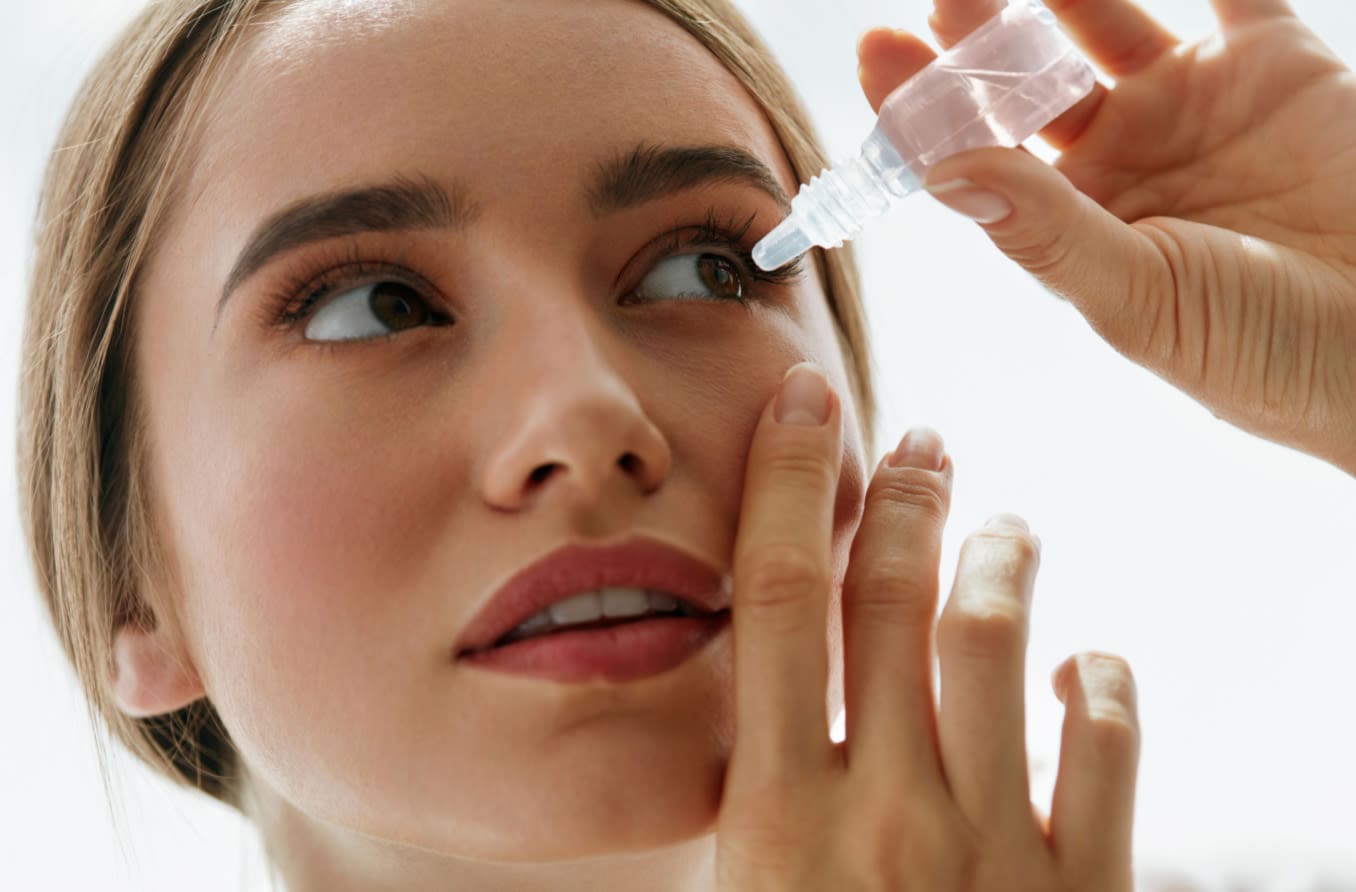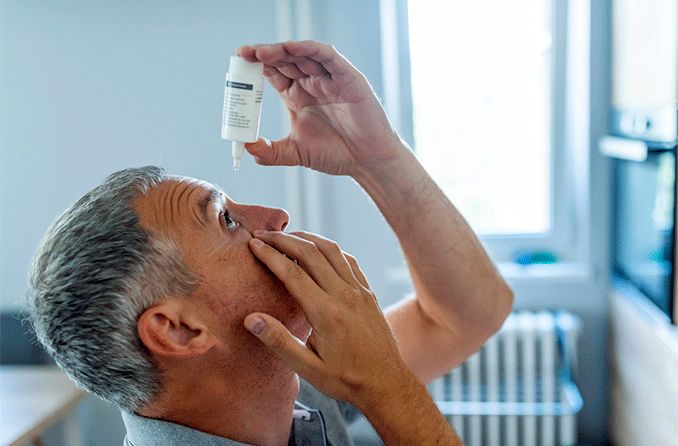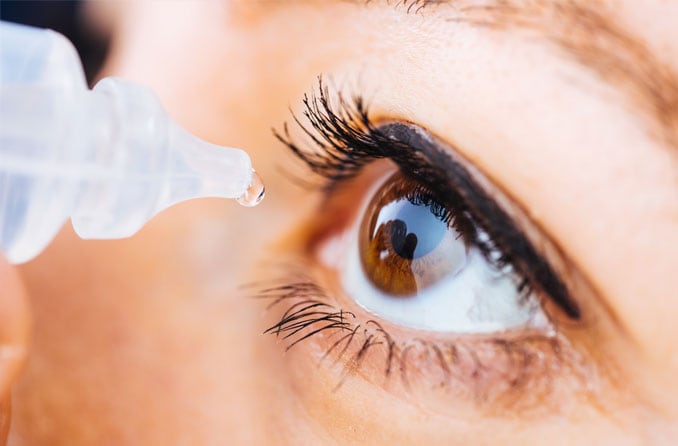What are artificial tears?
Artificial tears are eye drops that are available without a prescription and can be used as a first treatment for dry eyes and to relieve mild eye discomfort. These artificial tear drops are available over the counter in various brands and formulations.
What are artificial tears used for?
Artificial tears lubricant eye drops typically are used to treat mild eye discomfort and dryness that may be caused by a variety of factors. These may include eye conditions, environmental factors, excess screen time or eye surgery.
Here are some of the common uses for artificial tears:
- Different types of dry eyes or dry eye disease (DED)
- Eye discomfort caused by contact lens wear
- Eye fatigue caused by digital device use
- Eye dryness caused by LASIK or other eye surgery
- Allergies that irritate the eyes
Artificial tears are among the best types of eye drops for dry eyes. Some patients may also use redness relief eye drops for dry eyes but should do so with caution. The eye can become chemically dependent on these drops and make eye irritation worse in the long run.
The use of artificial tears may also help relieve discomfort after LASIK during the recovery period. If you’re having eye surgery, talk to your surgeon about which brand and type of artificial tear drops would be safe to use and work best for you.
Artificial tears can also be used to flush allergens from the eye. In the case of allergies, preservative-free artificial tears are the best, as preservatives in eye drops can make allergies worse.
What is in artificial tears?
Artificial tears lubricant eye drops have many different ingredients depending on the brand and product formulation. Some typical components of artificial tears along with their benefit to the eye include:
Lubricants
Ingredients that lubricate and protect the eye are called demulcents. All artificial tears include at least one demulcent. Some examples of demulcents used in artificial tears are as follows:
Cellulose ingredients bind to the surface of the eye and make tears thicker. This allows the tears to stay in the eye longer and provide better lubrication.
- Carboxymethyl cellulose (CMC)
- Hydroxypropylmethylcellulose (hypromellose, HPMC)
- Hydroxyethyl cellulose
- Methylcellulose
Dextran as well as gelatine are used to stabilize and moisten the tear surface.
Polyols are commonly found in sugar-free sweeteners and are also used as demulcents in eye drops.
- Glycerin
- Polyethyl glycol
- Polysorbate
Polymer demulcents are used in other health-care products such as the antiseptic povidone-iodine and is commonly used as an eye lubricant.
- Polyvinyl alcohol
- Povidone
Lipids
Fats or oils, also called emollients, are frequently added to artificial tear drops. Emollients stabilize the tear film by increasing the thickness of the oily layer and reduce evaporation.
Lipids help the product stay in place and work for a longer time, but they can also cause blurry vision. For this reason, it’s common to find them in formulas made for overnight use.
Artificial tear companies have developed special technologies that allow for better absorption of these lipids in the tear film. Examples of emollient ingredients are:
- Lanolin
- Mineral oil
- Paraffin
- Petrolatum
- Wax
Omega III fatty acids have been shown to reduce inflammation and may help with dry eye. Both Refresh and Systane brands have formulations with omega III fatty acids.
Redness relievers
Eye redness can be helped with compounds that constrict the blood vessels in the conjunctiva. These chemicals are added to artificial tears to provide immediate relief and whitening of the eye.
However, the conjunctival blood vessels can become chemically dependent on these, resulting in a drastic increase in redness once one stops the drops. Several brands have drops that sound similar, with one containing a redness reliever, the other one without.
Look carefully at the ingredients to see whether the following redness relievers are present:
- Naphazoline hydrochloride
- Tetrahydrazoline hydrochloride
An alternative redness relieving eye drop that has much less risk of rebound redness contains:
- Brimonidine tartrate
Salt concentration
Dry eye disease causes tears to contain too much salt. The average salt concentration of healthy tears is about 0.9%. When the concentration of tears is higher, they are called hypertonic.
Doctors who treat dry eye conditions may test the eyes for the presence of hypertonic tears. Artificial tears are available with a reduced salt concentration to re-balance the tear film. These formulations are called hypotonic. Some brands have this word incorporated into the brand name or may advertise that the tears are hypotonic.
On the other hand, in some cases artificial tears have an elevated salt concentration — in the range of 2%. These formulations are designed to reduce swelling of the cornea and are not meant to treat dry eye.
Preservatives
Some artificial tear formulas contain preservatives, while others are preservative-free (PF). An easy way to identify PF tears is that they generally come in a series of separate vials each with its own twist off cap. Most preservative-free brands also include PF in the name, and it is usually clearly shown on the label.
Benzalkonium chloride (BAK) is a preservative often used in artificial tears. This ingredient can cause problems with the cornea and with the tear film if you use the drops too often. Other, newer preservatives, such as Polyquad, Purite and sodium chlorite, may cause fewer issues.
Other additives
Artificial tears contain certain additives that may not be listed as the active ingredient. But they are often just as important in the effectiveness of an artificial tear brand.
Humectants
Humectants are compounds that keep things moist.
- Hydroxypropyl guar (HP guar) is a gelling agent that combines with two emulcents (polyethylene glycol and propylene glycol) to produce a more stable and thicker tear film.
- Sodium hyaluronate is found in many parts of the body, including the joints, skin and eyes, where it helps lubricate and retain moisture.
Osmoprotectants
Osmoprotectants are absorbed by dehydrated cells on the surface of the eye and can protect the eye against high salt concentrations in the tear film.
- Trehalose
- Erythrol
- Levocarnitine
Natural products
Some artificial tears have natural products added. One example is Manuka honey. This type of honey contains methylglyoxal and has been shown to have anti-bacterial and anti-inflammatory activity. It is thought that this is why it helps cure and comfort dry eyes.
Autologous serum tears
An advanced and under-used option for severe dry eye disease is when artificial tears are made up of someone’s diluted blood serum. These tears are called autologous serum tears. They contain antibodies, albumin, vitamin A and epidermal growth factors. These all help heal the damage and inflammation caused by dry eyes.
Homeopathic products
Homeopathic medicine is based on the principle that a compound that causes a disease can, when reduced to a very low concentration, treat the same disease.
In the case of dry eye disease, there are artificial tear products that contain alkaloids from plants. Examples include Euphrasia (eyebright) and belladonna (deadly nightshade) in very low concentrations.
The concentration is listed on the container as a number, such as 6X. This means that the compound is diluted one million times (10 to the power of 6). While homeopathic products contain very low concentrations of plant-based products, they should not be confused with herbal medicinal products. Herbal products contain much higher concentrations of plant-based compounds.
Thickness of artificial tears
The thickness of tears is called viscosity. Tears have different levels of viscosity. Slightly viscous drops are called a gel, and highly viscous artificial tears are described as an ointment.
Increasing the concentration of lubricants, such as CMC, increases the viscosity of artificial tears. Hyaluronic acid and hydroxypropyl guar are other compounds used to make a gel.
Petrolatum is used to make eye ointment. Eye ointments come in tubes while gels come in vials and dropper bottles. Ointments should be used before sleep, as they will blur vision. Even gels can temporarily blur vision and interfere with activities such as driving.
How to choose artificial tears
There are many brands of artificial tears to choose from, and the choice can be overwhelming for some patients. [Check out this guide on how to find the best eye drops according to your symptoms.]
Additionally, a few guidelines to help you shop for OTC artificial tears specifically:
- Ask your eye doctor. First, talk to your eye doctor about the best artificial tears for you. They may have a brand or formula recommendation specific to your needs.
- Look for the right formula. If your eyes get dry from blinking less while you stare at a screen all day, you might choose a general formula. Or consider one made specifically for dry eyes caused by digital device use. If you have moderate or severe dry eye disease, you may want to choose an artificial tears solution made specifically for DED in ointment or gel formula.
- Consider a preservative-free formula. Some eye doctors recommend preservative-free artificial tears because preservatives can irritate the eyes. This is especially true if you use artificial tears eye drops more than four to six times a day or if you have allergies.
- Be willing to switch if necessary. If you don’t get the relief you need, or if you experience side effects, try a different brand or formulation of artificial tears.
Dosage and how often to use artificial tears
When using artificial tears, follow recommendations from your eye doctor and dosing instructions outlined on the packaging.
You can use artificial tears multiple times per day. If you’re using a preservative-free formula, you can instill the drops whenever your eyes feel dry or irritated during the day. If you use artificial tears with preservatives, try not to use them more than four times a day.
A common misconception is that frequent use of artificial tears will make you dependent on them. This is not true. However, excessive use of artificial tears may indicate that additional treatment may be needed.
To use artificial tears:
- Make sure you wash and dry your hands well.
- Take out your contacts, if you wear them.
- Lie down or tilt your head toward the ceiling and look upward.
- Hold your lower eyelid and gently pull it forward to create a space to drop the artificial tear into.
- Holding the dropper over your eye, put a drop or two in each eye.
If you need more detailed instructions, check out this step-by-step guide on how to apply eye drops, such as artificial tears.
Side effects of artificial tears
Artificial tear eye drops are considered to be safe. However, there may be side effects, depending on the person and the product used.
Some side effects of artificial tears that have been reported by some patients include:
- Blurry vision
- Eye discomfort
- Foreign body sensation (a feeling of having something in the eye)
If you’re using a formula with preservatives and you use it too often, you could harm your eyes. For example, a common preservative can cause damage to the corneal nerves, harm cells in the eyes and cause problems with your tear film.
Talk to your eye doctor if you are taking artificial tears and experience any side effects or eye issues. They may recommend you stop using the product and switch to another brand or type of artificial tears. You may also ask your doctor whether, besides artificial tears, there are any other treatments they recommend to treat your symptoms.
SEE RELATED: Contact solution as eye drops?
